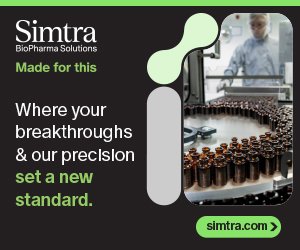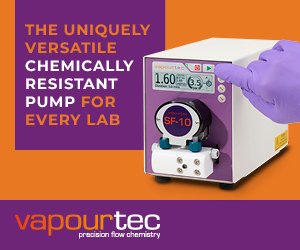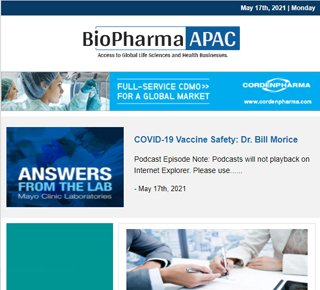Aptamer Group's Optimer-Fc: An Innovative Solution to Enhance Accuracy of Automated IHC Workflows
29 March 2023 | Wednesday | Influencers

Dr David Bunka, Chief Technical Officer at Aptamer Group
Aptamer Group's Chief Technical Officer, Dr David Bunka, speaks to BioPharma APAC about the innovative Optimer-Fc reagent solution for immunohistochemistry (IHC). Optimer-Fc is a solution to overcome the limitations of traditional antibodies used in IHC, providing improved target selectivity, the highest batch consistency, and a broader target range. The reagent is designed for automated IHC workflows and integrates the benefits of Optimer binders with the Fc portion of an antibody. Dr Bunka explains that Aptamer has extensively tested Optimer-Fc to ensure its consistent production and performance in recognizing and interacting with a secondary antibody. Optimer-Fc can expand the target range for IHC and has the potential to broaden the available disease biomarkers that can be analyzed. Additionally, Optimer-Fc has the potential to improve the accuracy of IHC and reduce cross-reactivity in assays.
- Can you tell us more about the Optimer-Fc and how it differs from other reagent solutions currently available for immunohistochemistry?
Optimer binders are oligonucleotide antibody alternatives that can be modified with various reporter groups for direct use in IHC, or as in the case of Optimer-Fc with the Fc portion of an antibody, to allow convenient integration into automated IHC workflows.
Antibodies have long been the gold-standard affinity reagent used in IHC but come with recognised limitations of target cross-reactivity, poor batch compatibility, the use of animals to generate the reagent, and the fact that antibodies simply can’t be raised to some targets. Optimer binders offer a solution to overcome these issues, with excellent target selectivity, the highest batch consistency, and as they are developed in vitro through three different processes tuned for target type, they offer a broader target range.
While IHC is performed in some labs using direct labelling, which would allow an antibody or Optimer to be used without a secondary reagent in IHC, we recognised that within larger research labs, pathology and clinical diagnostics, scientists rely on automated processes for increased throughput and consistency. These automated processes use both a primary antibody for target localisation in the tissue, and a secondary antibody for signal amplification. As Optimer binders are typically non-immunogenic developing a secondary reagent directly to the Optimer was not an easy option to support these scientists with the benefits of this technology. Instead we innovated and developed Optimer-Fc. Optimer-Fc is an Optimer binder, bringing the benefits of improved target range and selectivity, conjugated to the Fc portion of an antibody. This reagent can be integrated into current automated IHC workflows, allowing scientists to pursue new biomarkers in IHC and increase the accuracy of their assays.
- What kind of research or experiments has been conducted with Optimer-Fc, and what were the results?
We were initially made aware of our customers’ need for these reagents last summer, and we worked as a team to innovate and develop Optimer-Fc. This process involved taking some of our current Optimer binders that we have developed in-house and conjugating them to the Fc portion of an antibody.
Key points in this journey were: 1) to make sure that the Optimer-Fc reagents were able to be consistently conjugated to the Fc domain; 2) that the Optimer-Fc reagents were able to bind to their target following conjugation; and 3) demonstration that once the Optimer-Fc has bound to its target it was able to be recognised by a secondary antibody. All of this work has been repeated across multiple different Optimer binders to ensure the consistency and reproducible nature of the work. At Aptamer Group, we must be confident in the science and production of this technology before we offer this to our customers. Now we have demonstrated that Optimer-Fc can be consistently produced and performs as expected in terms of target recognition and secondary antibody interaction for IHC protocols we are pleased to offer this to our partners globally.
- Are there any potential limitations or challenges associated with using Optimer FC, and how do you address them?
We haven’t seen any limitations or challenges in the use of Optimer-Fc, and we haven’t had these reported from our partners who are trialing these reagents. The whole idea behind Optimer-Fc is to bring the advantages of target range and selectivity of Optimer binders to automated IHC workflows. In this application, Optimer-Fc simulates an antibody reagent but brings the performance characteristics of Optimer. Of course, for each different Optimer-Fc recognizing a different target, the working concentration would need to be optimized through a titration range exactly as you would for a primary antibody.
- Can you discuss the potential impact of Optimer-Fc on the field of immunohistochemistry and its potential applications in clinical settings?
The IHC market is composed of three major segments – diagnostics, research and forensics, with diagnostics being the dominant segment. For example, in 2020, hospitals and diagnostic labs accounted for just under three-quarters of the IHC market. These users typically employ automated IHC workflows, which Optimer-Fc has been designed to support.
IHC is used in patient diagnosis and prognosis and is widely regarded as the gold standard in clinical diagnostics. IHC enables diagnosticians to analyze a broader range of disease biomarkers compared to traditional enzyme staining techniques, which can only identify a limited number of proteins, enzymes and tissue structures. Optimer-Fc can expand this target range even further to allow new disease biomarkers to be analyzed. There is even the potential to develop Optimer binders in a hypothesis-free manner, using screening of disease vs healthy cells to identify novel biomarkers for these diseases, where the Optimer binder can then be used in downstream IHC assays. So Optimer-Fc has the potential to broaden the range of available disease biomarkers that can be analyzed in IHC for more accurate disease biomarkers and biomarkers for new diseases. Another impact of Optimer-Fc is to improve the accuracy of IHC: potential cross-reactive targets can be incorporated into Optimer discovery processes to allow increased target selectivity compared to traditional antibodies. The use of Optimer over antibodies could thus reduce cross-reactivity in these assays and offer increased accuracy in biomarker ID and monitoring.
- How does Aptamer plan to market and distribute Optimer-Fc to potential customers, and what is the target audience for this product?
Our target audience for this product is users of automated IHC who require primary antibody alternatives to explore new biomarkers or improve the reproducibility and selectivity offered through their current antibodies.
Our standard approach at Aptamer Group is to develop custom Optimer binders for our partners. These binders are applied in fields from research and diagnostics to therapeutics and bioprocessing. For Optimer-Fc we still aim to develop Optimer reagents to novel biomarkers or to validated biomarkers where the performance of current antibodies is not sufficient. We can then engineer these newly custom developed Optimer binders into the Optimer-Fc format for our customers’ use. We will offer Optimer-Fc to our current partners where it is the right solution for their problem, and are actively looking for new partners that could improve their processes with Optimer-Fc.
- Can you talk about any collaborations or partnerships that Aptamer has formed with other companies or organizations in the biopharmaceutical industry?
For Optimer-Fc, we are working with two of the top ten pharma companies who wish to trial the molecule in their labs. This work will provide important validation data from some of the best research labs in the world regarding the performance of Optimer-Fc, and help us to fine-tune the process of integrating Optimer-Fc into these systems going forward.
More broadly, we have a number of active collaborations with partners covering Optimer applications from research reagents to the development of Optimer as targeted delivery vehicles to form part of a therapeutic moiety.
- How does Aptamer ensure the quality and consistency of its products, including Optimer-Fc, and what kind of quality control measures are in place?
Following Optimer discovery and development, we run extensive quality checks, characterization and validation of our binders. Optimer affinity and cross-reactivity is tested as standard, with further validation dependent upon the end use of the binder. For example, if our partner’s primary application is IHC, we will test the Optimer in this application. Additional checks include ensuring the Optimer binders are not degraded and cleaned up following synthesis. For Optimer-Fc, further checks are required to ensure that the Optimer still recognizes its target and is not cross-reactive once bound to the Fc portion, and that a secondary antibody can recognise Optimer-Fc.
Optimer binders are synthesized via well-established, scalebale processes through in vitro methods, rather than generated through biological systems, like protein reagents. This ensures the highest batch consistency for Optimers compared to protein-based alternatives and delivers reliable reproducibility in performance for researchers.
- Can you provide any information about the pricing and availability of Optimer-Fc, and how it compares to other reagent solutions in terms of cost and accessibility?
Optimer-Fc will be developed on a custom basis rather than as an off-the-shelf reagent. As we custom develop Optimer binders, they typically are integrated into that partner’s experimental processes rather than being available through catalogs. But you never know, and perhaps once we have a suitable panel to launch, we could look at making this available to customers.
- Finally, are there any exciting developments or new products on the horizon for Aptamer that you can share with our readers?
We are always seeking to remain at the forefront of aptamer technologies. In addition to discovering and developing Optimer binders for our partners, we also offer a range of validation and assays development services. Our services can be used to demonstrate the performance of their developed binder or offer initial methods that can be transferred to partner’s labs for a turnkey solution, reducing the burden on their staff for assay optimization.
Additionally, we are currently developing Optimer+, our new discovery and development platform. Optimer+ integrates protein side chains into a DNA aptamer backbone for new affinity ligands that combine the best of both worlds from aptamers and protein affinity ligands. These ligands will have the potential to address an even broader target range and offer increased stability for potential use in vivo as therapeutics.
Most Read
- Top 25 Biotech & Biopharma Leaders in Sustainable Innovation, 2025
- China’s Biopharma Dealmaking Surges in H1 2025, Driven by Record Licensing and Oncology Focus
- Chikungunya in China: How a “Forgotten” Arbovirus Found the Perfect Storm
- How Innovation Gaps in Biopharma Raise New Safety Concerns
- Smart Implants and the Future of Musculoskeletal Injury Treatment
- How Ethical Gaps in Psychiatry Could Undermine Biopharma Progress
- The Evolving Landscape of Women’s Health Innovation in the Asia-Pacific
- Using NLP-Driven Decision Support in Emergency Health Assistance
- Taiwan Steps Into the Global Spotlight With a New Cancer Therapy
- The Role of Unique Device Identification (UDI) in Tracing Medical Device Safety
- The Importance of a Patient’s Mental Health During Clinical Trials
Bio Jobs
- The State of Biotech and Life Science Jobs in Asia Pacific – 2025
- Avantor’s New CEO Ligner Aims to Unlock Global Potential and Deliver Shareholder Value
- AstraZeneca Commits $50 Billion to U.S. Expansion by 2030 in Biggest-Ever Global Investment
- Thermo Fisher, SAMRC, and South Africa’s Department of Science and Innovation Launch CATIR to Nurture Next-Gen Scientists
- Cube Biotech Appoints Former Sartorius CEO Dr. Joachim Kreuzburg to Board of Directors
- FDA’s AI Transition Marks a Turning Point in Drug Review: Industry Faces Pressure to Adapt Amid 20% Workforce Cut
- WuXi XDC Completes Mechanical Build of Singapore Bioconjugate Manufacturing Hub
News
Editor Picks











